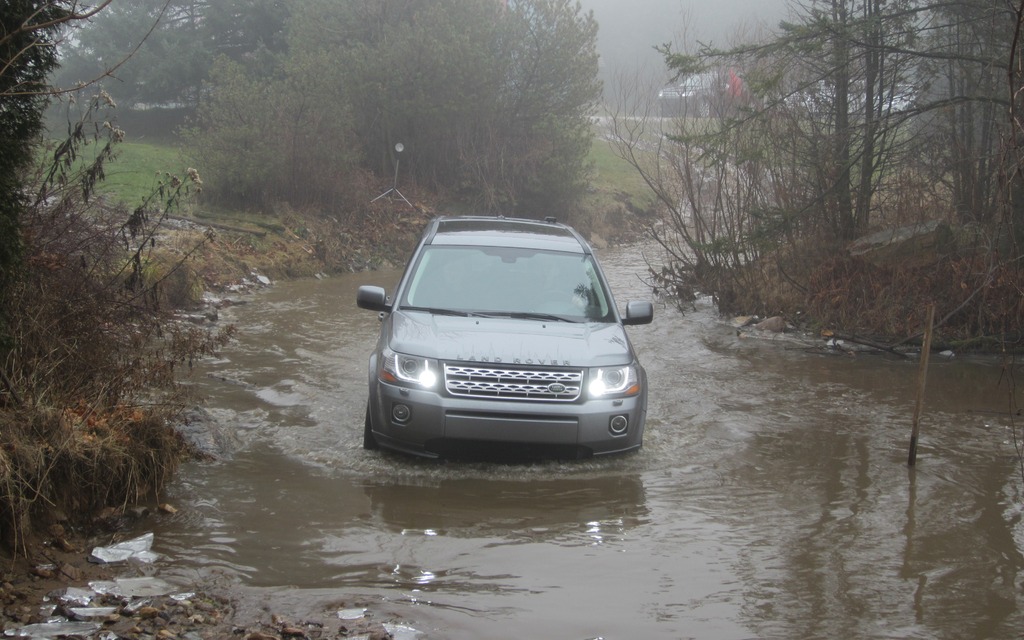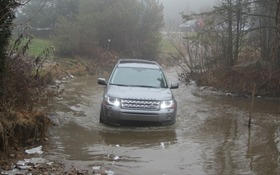2013 Land Rover LR2: Off-Roading In Compact Luxury Style
Not many owners will ever expose their compact SUVs to any type of driving more rugged than crossing an open field or creeping down a rutted road on the way to the cottage in the spring. That doesn't mean, however, that Land Rover is about to start watering down its most affordable offering, the recently refreshed 2013 Land Rover LR2.
In fact, some might argue that the small luxury 'ute is amongst the most off-road capable of its entry-level premium brethren - a possibility we were all too willing to put to the test when we were asked by the British brand to pilot the new LR2 across a challenging, rock-strewn trail that cut through snow-covered forests and muddy pits north of Montreal. How did a vehicle more often associated with comfortable family transportation hold up when asked to defend the more hardcore aspects of Land Rover's all-terrain reputation? Surprisingly well.
Small And Simple Is An Advantage Out On The Trail
Although macho, jacked-up full-size trucks and SUVs riding on monster lift kits are typically associated with displays of off-road prowess, in reality a short wheelbase, light curb weight, and the briefest of front and rear overhangs are more important assets when tackling a wilderness route. Certainly ride height plays an important role in avoiding potentially damaging obstacles, and the Land Rover LR2's 8.3 inches of ground clearance (and almost 20-inches of water-wading depth) were in the plus column during our adventure, but the maneuverability of the compact SUV in rough circumstances was enlightening as we entered tighter sections of trail.
With this in mind, Land Rover afforded the 2013 LR2 only minor cosmetic enhancements compared to the previous year's model, adding LED tail lights, more chrome to the front grille, a fresh headlight design, and a range of new wheel options to the vehicle's small package. Under the skin, the lack of a full-frame design was made irrelevant by enhancing the LR2's unibody chassis with a more rigid, integrated front structure (that includes the bumpers) as well as substantial underbody skid plate armoring.
High Tech Solutions To Age-Old Problems
Of course, the 2013 Land Rover LR2 also brings a good deal of advanced technology to the table to complement its well-designed platform. The LR2 doesn’t feature a traditional four-wheel drive system but rather comes with all-wheel drive that makes use of a multi-plate wet clutch center coupling designed by Haldex. At this point, hardcore off-roaders are already tuning out, but although the system directs power almost exclusively to the front wheels during on-pavement driving, once wheel spin is detected it only takes 150 milliseconds to redirect torque to the rear axle.
That's all well and good for rain-slicked roads, but what makes the Land Rover LR2 a legitimate trail weapon is the pairing of its all-wheel drive feature with the Terrain Response system. Terrain Response is a full suite of off-road electronics that link the transmission, engine, traction control, stability control, and the vehicle's center coupling in order to appropriately tackle the surface that the Land Rover is facing. Terrain Response allows the driver to choose between Grass/Gravel/Snow, Mud and Ruts, and Sand settings (on top of its General Driving setting), via a simple console-mounted button. It also automatically engages hill descent control when more rugged options like Mud and Ruts are selected.
Conquering Mud, Water, and Unexpected Disaster
We were quite curious to see whether the 2013 Land Rover LR2 would be able to pull together the various and impressive highlights of its spec sheet and deliver an off-road performance that would not see us requiring a tow from one of the winch-equipped LR4's that broke trail ahead of us. The first obstacle presented to us by Land Rover's driving experience team was a relatively deep, ice-filmed pond, which the LR2 trundled through and shrugged off as though it were merely a puddle stretching across the highway. Up next was a more serious set of challenges that would test every aspect of the Terrain Response system. With the vehicle set to Mud and Ruts, we first climbed and then descended a series of narrow, slippery, and deeply rutted woodland trails. In some places, the ruts were so deep that it was possible to take one's hands off of the steering wheel and have the vehicle guide itself.
The Hill Descent feature worked admirably well during this portion of our adventure, maintaining a reasonable forward speed that would have been much more difficult for a human driver to modulate using the brake pedal - although it was disconcerting to tip over the edge of a pernicious, rocky cliff (or ultra-steep sand dune, as we would do later on in the day) and trust a computer to keep you from rapidly accelerating to your doom like some type of out-of-control luxury bobsled. We also navigated a set of moguls, or elephant bumps, in the LR2, which saw the vehicle tip up onto three and even two wheels for brief moments due to the uneven nature of the ground. The Land Rover remained surefooted even when delicately balancing on unstable lumps of uncertain composition, which was a testament to the all-wheel drive system's ability to locate and make maximum use of available traction.
Perhaps the most flattering compliment that we could pay to the Land Rover LR2's off-road ability came halfway through our journey during a rapid blast through a water-soaked pit that ended with a climb to the top of a small hill. Almost immediately after we had slowed to a stop, the vehicle's tire-pressure warning light came on and told us that we had a flat on the left-front tire - a fact that was confirmed visually by a member of the Land Rover team who came back to check on us. Given that we were sandwiched in between a convoy of other journalists riding in their own respective LR2s, and due to the forest that surrounded us, we were told to keep driving until we reached the end of the trail, where a spare would be waiting for us. And so we did, pushing the Land Rover on one rim and three tires across another mile or so of trail that was littered with the same combination of water, hills, and sharp rocks that had slashed our sidewall. Not once during this torture test did the vehicle feel unsafe, unstable, or incapable of getting us out of the trouble we had gotten ourselves into.
No Mere Soft-Roader
The 2013 Land Rover LR2 is an interesting paradox in the compact luxury segment. While it might seem strange that an automaker would go to such lengths to impart such a high degree of off-road acumen on a vehicle that will almost certainly never be regularly punished on the trail, the fact remains that Land Rover has a brand image to protect - one that stretches back many decades before sport-utility vehicles became co-opted as high capacity people movers.
Although the Land Rover LR2 shines in daily driving (in no small part due to the new, 2.0-liter, 240 horsepower turbocharged four-cylinder engine under its hood), it also deserves credit for delivering the kind of all-terrain performance that most typically associated with the Jeep and FJ Cruiser crowd. This helps to make the LR2 one of the more unique entries on the small luxury SUV market, and one that is worthy of Land Rover's heritage.












